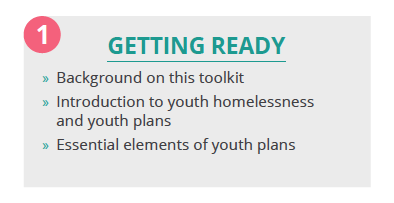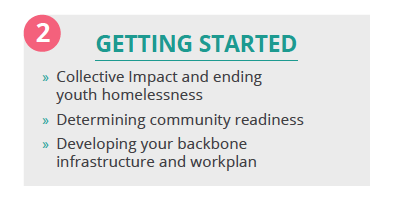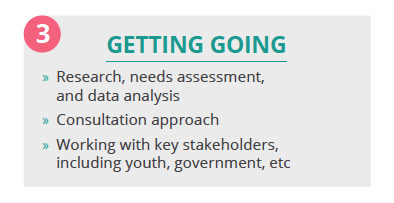Introduction
Considerable efforts are underway to effectively address youth homelessness in Canada, culminating in the creation of A Way Home – a national coalition focused on mobilizing communities and all levels of government to take action at a local and systems level. A Way Home is committed to supporting communities to advance evidence-based and strategic solutions, including the development of plans to prevent, reduce and end youth homelessness. Such plans can act as a stimulus for local and systemic change as part of collective actions to combat youth homelessness.
Ending youth homelessness involves a number of critical elements and actions. These include the implementation of innovative programs and housing solutions tailored for the specific needs of young people as well as structural changes within the operations of homeless-serving systems. The transformation of public systems, including child welfare, education, mental health, income supports and criminal justice and their enhanced integration which can facilitate broad systems of care is essential.
There are dynamics that are unique to each community that must be accounted for in local efforts and plans. For instance, the overrepresentation of particular demographics in the local homeless population, such as Indigenous youth, makes a difference in the design of interventions. Addressing the issue in a rural or urban setting impacts system planning approaches and resources needed considerably.
To support the enhanced capacity to respond to youth homelessness in unique local contexts across Canada, A Way Home has developed this toolkit to help communities create plans to prevent, reduce and end homelessness among young people.
This toolkit:
- Outlines the key elements of a systems approach to prevent, reduce and end youth homelessness using best and promising practices,
- Provides guidance to local communities on a step-by-step approach to develop plans that advance solutions to end youth homelessness,
- Highlights Canadian examples of innovation and locally developed resources to enhance knowledge exchange advancing the national movement and
- Is not intended to reinvent the wheel; where resources are readily available it points the reader to these as appropriate and draws on existing research and materials throughout.
The toolkit is designed as a resource for organizations and/or individuals considering or already leading community efforts to develop strategic responses to youth homelessness. Most likely, you are working in or with non-profit, government, lived experience and private sector stakeholders to explore your next steps. This toolkit will help you map out what needs to be done to get you started, across the finish line and beyond.
The toolkit is organized into four main sections:
Acknowledgements
Melanie Redman, A Way Home, Toronto
Mary-Jane McKitterick, A Way Home, Toronto
Stephen Gaetz, Canadian Observatory on Homelessness, Toronto
Dave French, Alberta Human Services, Edmonton
Sheldon Pollett, Choices for Youth, St. John’s
Giri Puligandlia, Homeward Trust, Edmonton
Kim Wirth, Boys & Girls Clubs of Calgary, Calgary
Kelly Holmes, Ray, Winnipeg
Naomi Leadbeater, Brandon Neighbourhood Renewal Association, Brandon, Manitoba
Debbie Bentley-Lauzon, Wyndham House, Guelph
Greg Bishop, Saint John Human Development Council, Saint John
Iris Hamlyn, Sidedoor, Yellowknife
Albert McLeod, Social Planning Council of Winnipeg, Winnipeg
Christina Maes Nino, Social Planning Council of Winnipeg, Winnipeg
Mike Bulthuis, Alliance to End Homelessness Ottawa, Ottawa
Deborah Hierlihy, Oriole Research & Design Inc.

Developed with support from the Government of Ontario.




